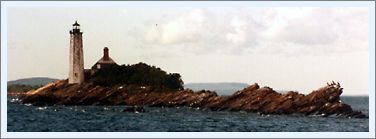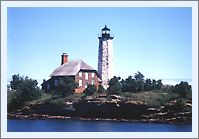|
Historical Information

Isle Royale lies out in Lake Superior some sixty miles to the north of
the Keweenaw peninsula, and a scant 14 miles south of the Canadian north
shore. It would be natural to assume that an island located so close to
the Canadian shore would be Canadian territory. However, during border
negotiations between the British and the nascent United States at the
Treaty of Paris in 1783, misunderstandings resulting from a lack of
accurate maps of the area caused the island to be included as part of
United States territory. While a number of Scandinavian fishermen would
set up operations on the island in the early 1800's, and John Jacob
Astor's American Fur Company would establish a trading post here in
1837, it would not be until the late 1840's that the United States
government would realize the windfall that resulted from the 1783
cartographic misunderstanding.
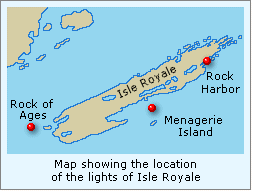 With the discovery of copper on the
island in 1843, two separate mining camps were established, one in
Siskiwit Bay on the southeastern end of the island and the other at Rock
Harbor to the north. To serve vessels seeking to load copper at the
latter, the Rock Harbor Light was established at the entrance to the
harbor in 1855. Unfortunately, simultaneous to the establishment of the
light, the copper boom on the island ended, and the Light was
extinguished and the station discontinued and abandoned in 1859 With the discovery of copper on the
island in 1843, two separate mining camps were established, one in
Siskiwit Bay on the southeastern end of the island and the other at Rock
Harbor to the north. To serve vessels seeking to load copper at the
latter, the Rock Harbor Light was established at the entrance to the
harbor in 1855. Unfortunately, simultaneous to the establishment of the
light, the copper boom on the island ended, and the Light was
extinguished and the station discontinued and abandoned in 1859
With the outbreak of the Civil War, and
a resulting increase in metals consumption, miners once again set their
sights on Isle Royale, and new and more efficient mines were established
at Siskiwit Bay on the southeast shore and McCargo Cove on the
northwest. Thriving communities grew up around these mines to support
the mining and shipment of copper, and with a resurgence in maritime
traffic making for the island to transport copper south through the
Sault Locks, the old Rock Harbor Light was reactivated in August, 1874.
 Realizing that Rock Harbor Light served
only traffic passing close to the harbor for which it was named, the
Lighthouse Board recommended that $20,000 be appropriated to construct
an additional lighthouse in the area in its 1872 annual report. While
Congress responded with the appropriation on March 3, 1873, the Board
was undecided as to the best location for the new station in order to
provide the greatest benefit. After considering a number of
alternatives, the decision was finally made in 1874 to locate the new
station on Menagerie Island, the most easterly of the group of small
islands at the opening of Siskiwit Bay. However, with winter beginning
to seize Superior in its icy grip, work on the island was not scheduled
to commence until the opening of the 1875 navigation season. Eleventh
District Engineer Major Godfrey Weitzel's plans for the station called
for both the tower and dwelling to be built of stone, and thus an order
was placed with the Jacobsville sandstone quarry, approximately 80 miles
south of Menagerie on the Keweenaw Peninsula, to reduce the cost of
transporting such heavy materials all the way from the Detroit depot. Realizing that Rock Harbor Light served
only traffic passing close to the harbor for which it was named, the
Lighthouse Board recommended that $20,000 be appropriated to construct
an additional lighthouse in the area in its 1872 annual report. While
Congress responded with the appropriation on March 3, 1873, the Board
was undecided as to the best location for the new station in order to
provide the greatest benefit. After considering a number of
alternatives, the decision was finally made in 1874 to locate the new
station on Menagerie Island, the most easterly of the group of small
islands at the opening of Siskiwit Bay. However, with winter beginning
to seize Superior in its icy grip, work on the island was not scheduled
to commence until the opening of the 1875 navigation season. Eleventh
District Engineer Major Godfrey Weitzel's plans for the station called
for both the tower and dwelling to be built of stone, and thus an order
was placed with the Jacobsville sandstone quarry, approximately 80 miles
south of Menagerie on the Keweenaw Peninsula, to reduce the cost of
transporting such heavy materials all the way from the Detroit depot.
The Lighthouse tender DAHLIA anchored
off Menagerie Island in the spring of 1875 and unloaded a working party
and all of the materials for construction with the exception of the
stone. While the working party busied itself building temporary living
quarters, a dock, and in blasting foundations for the tower and
dwelling, DAHLIA set sail for Jacobsville to load the stone quarried
over the winter. After returning to Menagerie Island and unloading the
stone, the tender departed, leaving the working party to continue
construction.
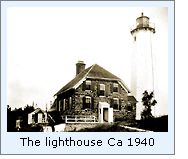 Over that summer the four buildings
which comprise the station took shape. The 61' tall sandstone tower was
constructed with double walls to provide stability, provide an air space
within the wall to reduce interior moisture, and to provide a
cylindrical inner support for the cast iron spiral staircase. Standing
16' in diameter at the base, the tower's exterior walls tapered gently
to diameter of 10' beneath the gallery. Supported by twin corbels on
each of its eight sides, the cast iron gallery assembled atop the tower
and outfitted with a tubular iron safety railing. At the gallery's
center, the prefabricated cast iron octagonal lantern was erected, and
the fixed white Fourth Order
Fresnel lens placed atop a cast iron pedestal. By virtue of the
tower's location on a high point on the island, the lens was situated at
a focal plane of 74 feet and was visible for a distance of 15 ½ miles.
On completion, the tower was whitewashed and the lantern and gallery
painted black to help the structure to serve as a more effective
daymark. The 1 ½-story dwelling was constructed of unpainted sandstone
and featured a gabled roof with partial hips at each gable end. The
dwelling was connected to the tower by way of an 8 foot long covered passageway
to provide protection for the keepers making their frequent trips to the
tower in inclement weather. With completion of a wooden storage shed and
a brick privy, work on the island was completed on September 20, 1875.
William Stevens was appointed as Acting Keeper for the station, and with
his wife appointed as Acting First Assistant, the couple arrived on the
island and moved their worldly belongings into the new dwelling in time
to exhibit the new light for the first time on the evening of October
19, 1875. Over that summer the four buildings
which comprise the station took shape. The 61' tall sandstone tower was
constructed with double walls to provide stability, provide an air space
within the wall to reduce interior moisture, and to provide a
cylindrical inner support for the cast iron spiral staircase. Standing
16' in diameter at the base, the tower's exterior walls tapered gently
to diameter of 10' beneath the gallery. Supported by twin corbels on
each of its eight sides, the cast iron gallery assembled atop the tower
and outfitted with a tubular iron safety railing. At the gallery's
center, the prefabricated cast iron octagonal lantern was erected, and
the fixed white Fourth Order
Fresnel lens placed atop a cast iron pedestal. By virtue of the
tower's location on a high point on the island, the lens was situated at
a focal plane of 74 feet and was visible for a distance of 15 ½ miles.
On completion, the tower was whitewashed and the lantern and gallery
painted black to help the structure to serve as a more effective
daymark. The 1 ½-story dwelling was constructed of unpainted sandstone
and featured a gabled roof with partial hips at each gable end. The
dwelling was connected to the tower by way of an 8 foot long covered passageway
to provide protection for the keepers making their frequent trips to the
tower in inclement weather. With completion of a wooden storage shed and
a brick privy, work on the island was completed on September 20, 1875.
William Stevens was appointed as Acting Keeper for the station, and with
his wife appointed as Acting First Assistant, the couple arrived on the
island and moved their worldly belongings into the new dwelling in time
to exhibit the new light for the first time on the evening of October
19, 1875.
The difficult conditions on the island
can be clearly felt from William's entry in the station log book on Oct.
26 1875, when he wrote "Damp and cloudy. The East northeast gale
increased almost to hurricane. At 6 AM the sea went clear over tower,
rocks and broke the window sashes on south side of the house. Washed
away everything loose, lumber, wood, rocks off the island." The
Williams' both received permanent appointments on November 18, 1876,
however their time on the island was not to be long-lived, as William
accepted a transfer to the less exposed and confining Portage Lake Ship
Canal Light on August 9, 1878.
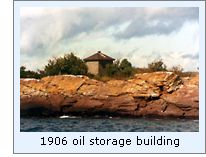 John H Malone was appointed to replace
Williams, and unlike his predecessor, chose not to have his wife serve
in any official capacity at the station, instead arranging for his
brother James to take the Assistant position. While life on Menagerie
Island was far from luxurious, it must have suited John and his wife
well, as they would end up staying on the island a remarkable thirty-two
years, raising twelve children in the shadow of the Menagerie Island
Light. Although a number of sources have reported that Menagerie Island
received its name for Malone's "menagerie" of children, this
appears to be pure fancy. Official government documents reporting on the
site chosen for the station in 1872 made specific reference to
"Menagerie Island." and since the Malones did not arrive on
the island until August 1878, the name was evidently in common use at
least six years in advance of their arrival, and long before their
family would have reached a number that could have been considered a
"menagerie." However, the size of their family is a matter of
record, and one can only imagine the trials faced by John and his wife
in raising and educating twelve children on such a small, barren island.
When considering the storms that ravaged the island, the fact that none
of the children ended up drowning in Superior's frigid waters is in
itself amazing. In one such storm on October 1, 1884, Malone's log entry
recorded that waves smashed over the island with such ferocity that the
boathouse and ways were completely ripped from their foundations and
carried away. John H Malone was appointed to replace
Williams, and unlike his predecessor, chose not to have his wife serve
in any official capacity at the station, instead arranging for his
brother James to take the Assistant position. While life on Menagerie
Island was far from luxurious, it must have suited John and his wife
well, as they would end up staying on the island a remarkable thirty-two
years, raising twelve children in the shadow of the Menagerie Island
Light. Although a number of sources have reported that Menagerie Island
received its name for Malone's "menagerie" of children, this
appears to be pure fancy. Official government documents reporting on the
site chosen for the station in 1872 made specific reference to
"Menagerie Island." and since the Malones did not arrive on
the island until August 1878, the name was evidently in common use at
least six years in advance of their arrival, and long before their
family would have reached a number that could have been considered a
"menagerie." However, the size of their family is a matter of
record, and one can only imagine the trials faced by John and his wife
in raising and educating twelve children on such a small, barren island.
When considering the storms that ravaged the island, the fact that none
of the children ended up drowning in Superior's frigid waters is in
itself amazing. In one such storm on October 1, 1884, Malone's log entry
recorded that waves smashed over the island with such ferocity that the
boathouse and ways were completely ripped from their foundations and
carried away.
In a violent storm on November 7, 1885,
the two year old Canadian Pacific luxury passenger propeller ALGOMA lost
control in the lake, and was blown aground on Greenstone Island off Rock
Harbor. Malone made note of the disaster in his log after learning of
the accident on the 9th, a few days before closing the station for the
season. On his return to reopen the station on May 12, 1886, reminders
of the wreck were evidently still visible in the area, as he noted in
the station log that "Indian boats pass with loads of furniture
from ALGOMA - chairs, lounges, bedsprings and feather pillows."
and seven days later, he recorded that "lifejackets, pillos
(sic), parts of a piano" were washing up along Menageries rocky
shore. 1886 was also the year in which John's brother George accepted a
promotion as Acting Keeper at the Minnesota Point Light on October 2,
1886, and was replaced by George Genry on the opening of the 1887
navigation season.
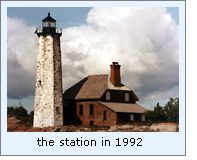 The Malones had to be resourceful to
supplement the supplies left by the lighthouse tender during the
District Inspector's infrequent visits to the station. They planted a
small garden in the sparse soil on the Menagerie, and managed to
successfully grew lettuce and radishes. They also maintained a potato
patch on nearby Wright Island, where the soil cover was considerably
deeper. Frequent mention was also made in the log books of fishing,
trapping, hunting rabbits and ducks, and the collecting of seagull eggs.
While seagull eggs might not sound appealing to our tastes of today,
they apparently constituted a considerable part of the family's diet.
They also appear to have represented some "trading value" with
the outside world, as Malone's log entry for June 1, 1887 stated that he
had "collected 1,478 gull eggs to date - 32 eggs blowed out for
supply vessel crew." What he might have traded for the eggs is
an interesting matter for speculation, and will likely never come to
light. The Malones had to be resourceful to
supplement the supplies left by the lighthouse tender during the
District Inspector's infrequent visits to the station. They planted a
small garden in the sparse soil on the Menagerie, and managed to
successfully grew lettuce and radishes. They also maintained a potato
patch on nearby Wright Island, where the soil cover was considerably
deeper. Frequent mention was also made in the log books of fishing,
trapping, hunting rabbits and ducks, and the collecting of seagull eggs.
While seagull eggs might not sound appealing to our tastes of today,
they apparently constituted a considerable part of the family's diet.
They also appear to have represented some "trading value" with
the outside world, as Malone's log entry for June 1, 1887 stated that he
had "collected 1,478 gull eggs to date - 32 eggs blowed out for
supply vessel crew." What he might have traded for the eggs is
an interesting matter for speculation, and will likely never come to
light.
 As was the case with the keepers
assigned to most of Superior's offshore lights, the Malones only lived
on the island during the navigation season, spending their winters in
Duluth. Under normal circumstances, one of the lighthouse tenders was
expected to take them out to the island in early May with the
disappearance of most of the lake ice, and then return to retrieve them
in mid November before the ice grew too thick to allow the vessels to
penetrate However, life on Menagerie was far from normal, and in those
frequent situations in which the tenders were unavailable, Malone was
left to his own devices to make his way to and from the island. In his
first entry in the station log for 1889, Malone documented the harrowing
and circuitous journey he took to get out to his station that year as
follows: As was the case with the keepers
assigned to most of Superior's offshore lights, the Malones only lived
on the island during the navigation season, spending their winters in
Duluth. Under normal circumstances, one of the lighthouse tenders was
expected to take them out to the island in early May with the
disappearance of most of the lake ice, and then return to retrieve them
in mid November before the ice grew too thick to allow the vessels to
penetrate However, life on Menagerie was far from normal, and in those
frequent situations in which the tenders were unavailable, Malone was
left to his own devices to make his way to and from the island. In his
first entry in the station log for 1889, Malone documented the harrowing
and circuitous journey he took to get out to his station that year as
follows:
"April 30, 1889. Arrived at
this station today, had quite a hard trip. Left Duluth April 22nd per
Steamer Ossigridge. Layed-over Two Harbors due to nor'easter. Left Two
Harbors on 23rd for Grand Marais. Stayed till 25th. Snowed 4 inches.
Left Grand Marais 25th, arrived at Washington Harbor 8:20 AM on 26th.
Left Washington Harbor 11:30 per Brower tug, and arrived at Tobin's
Harbor at 6:20 PM. Left Tobin's Harbor 10:20 AM the 27th, and arrived at
Wright's Island abreast of lighthouse. Stayed until 2:10 PM April 30th.
6 inches snow fell. Arrived at crib at 3:20 in tail end of gale. Water
had dropped 14 inches. We got our provisions and selves all wet. Had to
buy a boat at Tobin's Harbor as water too low to launch lighthouse boat.
We found station dry and in good shape. Lighted the lamp."
Not surprisingly, after being born and
raised on the island, lighthouse keeping was in the blood of the Malone
family. When First Assistant Alexander McLean was promoted to the
position of Keeper of the Eagle Harbor Ranges on January 15, 1900, one
of Malone's sons John A Malone took over as the station's First
Assistant under the watchful tutelage of his father.
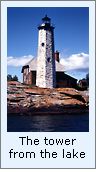 Prior to the 1890's, lamp oil had been
stored in storage rooms within the dwellings at almost all US light
stations. As a result of a number of fires from the increasingly
volatile kerosene being used, a system-wide project of erecting separate
oil storage buildings some distant from the dwellings was undertaken in
the early 1890's. Perhaps indicating the low position in which the
Menagerie Island Light was held in the greater scheme of things by the
Eleventh District office, the island was one of the last stations in the
district to be outfitted with such an oil storage shed in 1906, when a
work crew arrived with materials to construct a concrete 500 gallon
capacity storage building. Prior to the 1890's, lamp oil had been
stored in storage rooms within the dwellings at almost all US light
stations. As a result of a number of fires from the increasingly
volatile kerosene being used, a system-wide project of erecting separate
oil storage buildings some distant from the dwellings was undertaken in
the early 1890's. Perhaps indicating the low position in which the
Menagerie Island Light was held in the greater scheme of things by the
Eleventh District office, the island was one of the last stations in the
district to be outfitted with such an oil storage shed in 1906, when a
work crew arrived with materials to construct a concrete 500 gallon
capacity storage building.
Perhaps growing weary of life on the
small island, John H Malone accepted a transfer to Pipe Island after an
incredible 32 years as keeper of the Menagerie Island Lighthouse.
However, the Malone name was not to disappear from the payroll records
of the station, as First Assistant Keeper John A Malone was promoted to
the position of Keeper on his fathers departure for Pipe Island on
October 12, 1910
By the end of the first decade of the
new century, the copper mines on Isle Royale had all ceased operations
and maritime traffic in the area dwindled to virtually nothing, and in
order to reduce costs, the gears were turning at the Detroit office to
automate the Menagerie Island Light. In 1913, a work crew arrived at the
station and installed an acetylene lighting system equipped with an
automatic sun valve. With an iron vault containing three acetylene
cylinders located on an exterior wall of the dwelling, sufficient
acetylene was available to keep the light burning for the entire season
without refilling. With automation, the constant attention of keepers at
the station was no longer deemed a necessity, and John A Malone resigned
from lighthouse service and left the island, thus ending a remarkable 38
year association of the Malone name with the Menagerie Island Light.
October 29, 1915 saw a change in the
characteristic of the acetylene light to show a white half-second flash
every 5 seconds. Other than annual trips to refill the acetylene tanks
and to troubleshoot problems with the light reported by mariners, things
on the island stayed unchanged until 1941, when the acetylene system was
replaced by a battery powered lighting system. This battery system was
finally removed in 1993, and replaced with a 12 volt solar powered 300
mm Tidelands Signal acrylic optic with automatic bulb changer, which can still be seen
casting its light ten miles into the darkness to this day.
Keepers of this
Light

Click here
to see a complete listing of all Menagerie Island Light keepers compiled by
Phyllis L. Tag of Great Lakes Lighthouse Research.
Finding this Light

The Voyageur
II, a 60' aluminum diesel cruiser transports mail and passengers
to Isle Royale. The vessel leaves Grand Portage, Minnesota and travels
clockwise around the park, staying overnight at Rock Harbor. Along the
way, it passes close to Menagerie Island, and photographs of the
lighthouse should be possible with a telephoto lens of around 500 mm
focal length (10x digital.)
For close-up views of the lighthouse, a
private boat or a charter boat out of Grand Portage would likely provide
the best opportunities.
Keweenaw Excursions also offers a
lighthouse cruise which passes Menagerie Island on board the KEWEENAW
STAR out of Houghton, Michigan. For more information on any of their
tours visit their website,
or telephone Keweenaw Excursions at (906) 482-0884.
Reference Sources

Annual reports of the Lighthouse Board, various, 1878 - 1909
Annual report of the Lake Carrier's Association, 1915
Great Lakes Light Lists, various, 1901 - 1997
Log books of the Menagerie Island Light, transcribed by Don
Nelson.
Northern Lights, Charles K. Hyde
Email correspondence with Don Nelson, various, 2002
Photographs of the station courtesy of Don Nelson & Wayne Sapulski.
Isle Royale National Park, foot trails & water routes, Kim
DuFresne, 1984
Keeper listings for this light appear courtesy of Great
Lakes Lighthouse Research
|
